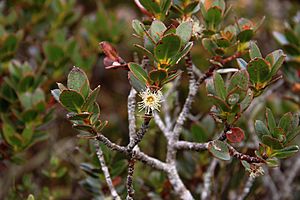Varnished gum facts for kids
Quick facts for kids Varnished gum |
|
|---|---|
 |
|
| Scientific classification | |
| Genus: |
Eucalyptus
|
| Species: |
vernicosa
|
The Eucalyptus vernicosa, also known as varnished gum, is a special type of shrub or small tree. It grows only in the mountains of Tasmania, an island in Australia. This plant gets its name "varnished gum" because its leaves are shiny, almost like they've been varnished! It has smooth, grey bark, and its leaves are often crowded together. Its flowers are white, and its fruits look like small bells.
Contents
What is the Varnished Gum?
The varnished gum is usually a shrub, growing about 1 meter (3 feet) tall. Sometimes, it can grow into a small, multi-stemmed tree called a mallee, reaching up to 4 meters (13 feet) high. It has smooth bark that can be grey or brownish-grey.
Leaves of the Varnished Gum
Young varnished gum plants have shiny, green leaves shaped like eggs. These leaves are about 7 to 20 millimeters long and 3 to 15 millimeters wide. They grow directly on the stem without a stalk, and they are arranged in pairs opposite each other.
As the plant gets older, its leaves stay shiny and green. They can be egg-shaped, oval, or even round. These adult leaves are a bit bigger, about 10 to 32 millimeters long and 8 to 15 millimeters wide. They have a rounded base and grow on a short stalk called a petiole.
Flowers and Fruit
The flowers of the varnished gum are white. They grow in small groups of three, right where the leaves meet the stem. Sometimes, you might only see one flower bud. These buds are oval-shaped, about 8 to 9 millimeters long. They are greenish-brown and look a bit wrinkled.
The varnished gum can flower almost all year round, but it blooms the most from December to February. After the flowers, the plant produces woody fruits. These fruits are shaped like a half-sphere or a bell, about 5 to 8 millimeters long.
Where Does the Varnished Gum Grow?
The varnished gum is found only in Tasmania, specifically in the alpine (high mountain) areas of the west and southwest. You can find it in places like Cradle Mountain. It usually grows at high altitudes, between 700 meters (2,300 feet) and 1,350 meters (4,400 feet) above sea level.
Its Mountain Home
This plant prefers peaty, acidic soils, which are often found on top of quartzite or sandstone rocks. It typically grows above the tree line, which is the elevation where trees stop growing due to harsh conditions. The varnished gum is an important part of the alpine heath communities there, growing alongside other plants like Richea and Athrotaxis.
The weather in these areas is very cold, with lots of rain (1,000 to 2,500 millimeters per year). Winters bring continuous frosts and snow for several months. The tough climate and poor soil are why the varnished gum stays small and has strong, tough leaves.
Why is the Varnished Gum Special?
Scientists used to think that the varnished gum was closely related to two other Tasmanian eucalyptus species, E. johnstonii and E. subcrenulata. They noticed that these plants changed their appearance depending on how high up the mountain they grew. This made scientists believe they were all part of one species adapting to different environments.
However, newer studies looking at the plants' DNA show that the varnished gum is actually not as closely related to E. johnstonii and E. subcrenulata as once thought. The similar appearances are likely due to something called parallel evolution. This means different species can develop similar traits if they live in similar environments, even if they are not closely related.
Uses of the Varnished Gum
Growing Varnished Gum in Gardens
Some types of Tasmanian alpine eucalyptus, including the varnished gum, are grown as ornamental trees and shrubs in Europe, especially in the United Kingdom. People like them because they stay green all year round, and the climate in places like the UK is similar to Tasmania's, which helps them grow well.
Traditional Uses of its Oil
In the early 1900s, people used to collect the oil from the varnished gum. They believed this oil had special properties that could be used as medicine.
Images for kids


